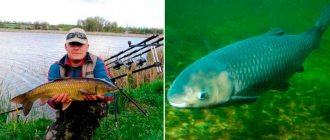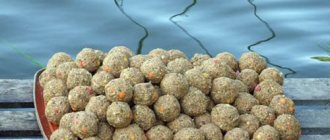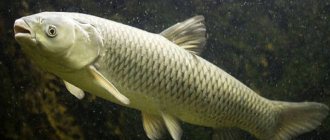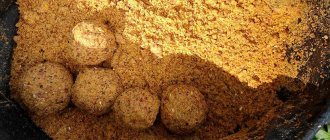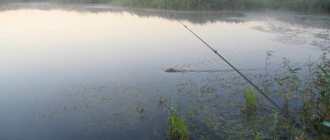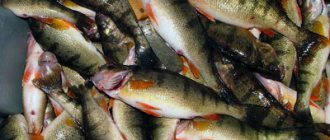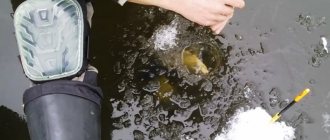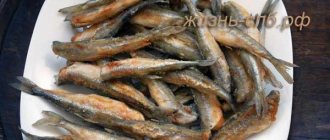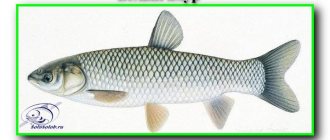What do grass carp bite on?
Grass carp likes the following baits:
- for “bulk” (feed), but not granulated;
- cucumbers
By the way, the attention of White Cupid is attracted not by the food itself, but by the splash itself and the falling specks of dust.
A couple of tips when fishing:
- Don’t forget that grass carp clears an area and then swims away to another place , so it’s worth constantly adding bait.
- Yes, as for bait, it must be of good quality, and be quite a contrasting and nutritious mixture, containing a variety of aromatic, flavoring and sweet fillers.
- Don’t skimp on buying bait for catching grass carp. By skimping on bait, your chances of catching become very small.
Catching grass carp with a plug
To catch grass carp on a plug we need:
- A carp plug, but it will be needed when purposefully catching large fish; such plugs are suitable for almost all fishing rods, the price of which ranges from 500-700 dollars.
- Having a length of 13 cm, they are very heavy and cannot boast of structure.
- Shock absorber (select according to the size of the hook and the diameter of the leash that will be used for fishing).
Catching grass carp with a match fishing rod
Catching fish such as grass carp on tackle with match rods is a pleasure, it will bring you excellent results. The drag on the match reel is very easy to cope with cupid of almost any weight, unless it starts to go into the grass.
So, let's begin:
- Use fishing line no more than 0.7 mm, and make a leash from fishing line no more than 0.6 mm. And the best hook will be numbered either 7 or 9.
- When casting, it is worth strengthening the bait with floss thread.
- When catching this fish, you should act very quickly, because if you miss one moment, you will lose the fish.
Nutrition:
- Young individuals feed on crustaceans and moths, and when they become adults they switch to vegetation.
- Adult fish switch to a herbivorous diet; they feed on terrestrial grass and underwater algae.
- It is worth noting that cupid feeds on greenery that grows in reservoirs and can eat it all, then in such cases it is worth mowing the grass and throwing it to them.
- By eating vegetation and grass, cupid also prevents mosquitoes from breeding, thereby creating favorable living conditions for nearby residents who are or live near the fish’s location.
When feeding on grass, the grass carp can eat as much of it as it weighs, which is why they are released to clean excess grass from rivers, ponds, lakes, irrigation water systems, and also into the coolers of hydroelectric power plants.
Catching grass carp with young cucumbers
Now we will look in detail at exactly how to catch fish with cucumbers.
First, cut the cucumber into cubes and put it on the hook. After preparing everything necessary for fishing, we try to carefully throw the hook into the water without creating unnecessary noise or splashes. It is also worth remembering that under no circumstances should the fishing line overlap the fishing area.
If, nevertheless, the fish stumbles upon the fishing line, it will leave the area. The bite is very strong, the line is pulled very sharply. When you pull sharply and quickly hook it, otherwise the fish will take the tackle into the writhing. Fishing will take longer. The fish will resist very much, try to break away, if this does not work, it walks in circles. At this important moment of fishing, do not even think about letting go of the line, otherwise you will be left without a fish and with a torn line in your hands. You need to slowly and carefully bring the carp to the shore, and then take it into the landing net.
With the right approach to fishing, you can catch 10 of these specimens. Catching White Cupid is not uncommon, it just happens that the gear cannot withstand the load of such a heavy and strong fish.
Bait for catching grass carp
When fishing, it is worth considering one very significant factor: cupids process food very poorly, they are “insatiable.” The first time you should throw 2-3 kilograms of bait, and then gradually throw another 2-3 kg a couple of times using a special scoop or feeding rocket. You can also make a sandwich from a floating nut and artificial corn, thus creating a contrast that attracts grass carp.
The fish does not “run” to a huge amount of food; it will swim up to good bait with interest. Also an important factor is the spray; it can be purchased at markets and stores.
What do grass carp bite on in summer?
The most optimal time of year for catching this fish is autumn - spring, when the weather is good, sunny and warm. If there is enough food in the river or pond, then the fish will never turn their attention to the food that the fisherman offers.
The best natural bait for fish is young, fresh grass, as well as:
- ovaries of young cucumbers and corn;
- aloe leaves;
- algae with filamentous structure;
- young reed;
- bunches of young pea leaves;
- clover, etc.
Various flavoring and essential oils are mixed into the bait.
Taking into account the fact that the fish is a herbivore, it can also peck at the earthworm. The bait should be cast close to the expected location of the fish, then slowly pull it there. The bite occurs at lightning speed and immediately swallows the bait on the hook. It is necessary to have time to quickly and sharply hook.
Having realized that you have a fish on your hook, pull it to the shore as quickly as possible, not allowing it to leave; it will naturally circle, but try not to let it do this. In the worst case, she will simply break loose and go into the thickets where you cannot reach her. Grass carp is a strong and very hardy fish.
What do you use to catch grass carp in June - July?
Let’s look point by point at everything that concerns the bite during the June-July period.
Grass carp is a large representative of the family of herbivorous fish, for which it is nicknamed “grass carp.” Its diet includes aquatic and terrestrial grass that grows near bodies of water. It lives in places overgrown with grass and other aquatic vegetation, which is the only source of food for fish.
At a temperature of 25-30°C, the weight of its daily diet can sometimes exceed the weight of the fish itself. As the temperature decreases, the intensity of food absorption also decreases. At temperatures below 10°C it simply stops eating.
It is also possible to breed grass carp and carp very effectively, as this increases production efficiency because carp is not a competitor to grass carp in terms of food supply.
The density of habitat of one-year-old grass carp strongly depends on the overgrowth of water bodies. The number of fish should not exceed 1-2 specimens per 10 square meters if the vegetation in the reservoir is developed in medium quantities. The number of carp should be no higher than 10-15% in relation to the number of carp.
Lures and baits
Catching carp on a feeder will be successful if you use a large amount of high-quality bait and selective baits. If there is a sufficient amount of algae and other plants in the reservoir, grass carp will most likely give preference to the food that is familiar to it.
In order not to be left without a catch, it is advisable to feed the promising future fishing spot with cereals for 2-3 days, which will then be included in the bottom bait. Grass carp is especially responsive to corn. You can use ready-made carp pellets.
It is necessary to feed the fish during the fishing process. At the same time, bait cannot be saved: to attract and keep grass carp at the desired point in the reservoir, at least 5 kg of food per day is required.
When filling the feeder, be sure to add products to the mixture that, when washed out, form a column of turbidity: milk powder, oatmeal, semolina. Grass Cupid has a sweet tooth. It actively responds to bait flavored with condensed milk and honey.
Fish have a good sense of smell. She is attracted to fruity aromas, the smell of garlic and dill. A decent catch is provided by a mixture of dough (can be replaced with soaked bread) with squashes, young reed stalks or fresh cucumbers rolled through a meat grinder.
Important! Vegetable mince is added to the dough directly during fishing. Otherwise, the bait will quickly turn sour. You can prepare the following bait in advance, which is characterized by high catchability:
You can prepare the following bait in advance, which has high catchability:
- millet or rolled oats porridge (1 kg of finished product);
- 3–4 pcs. boiled potatoes;
- crumb of rye bread;
- semolina (1 cup);
- a can of canned corn (can be replaced with sweet corn flakes);
- 2 bananas, mashed to a paste.
Mix all components thoroughly. If the consistency is not viscous enough, you can add semolina. An effective biting activator is the poppy seed. It can be added to any bait.
Read How to catch perch using a spinning rod and what gear to use
The choice of baits is determined by the feeding habits of grass carp. Fish cannot be considered an absolute vegetarian. During the spring feeding period and in the summer after spawning, the fish bite well on maggots, dung worms, and bloodworms.
Plant baits always remain a priority. Fishing for grass carp using young cucumbers is recognized as the most effective. Some fishermen specifically grow them on the windowsill. It is advisable to use a cucumber ovary with a flower as a bait for the donk.
The cucumber must be planted in such a way that the hook is hidden in the flower.
Positive buoyancy prevents the cucumber from sinking to the bottom, which makes it an attractive food for grass carp.
Among other plants that have proven themselves well:
- potato;
- corn stalks;
- a bunch of algae from a fishing pond;
- green pea leaves;
- clover;
- cane;
- squash;
- cabbage leaves;
- dandelion.
These baits are considered selective: they only catch grass carp.
Like all carp, carp responds well to boilies with fruity smells, especially if they are of high nutritional value for him, that is, enriched with vitamins, carbohydrates, and minerals.
Grass carp is a picky eater. Often anglers have to experiment with baits and baits, so you need to have several food options with you.
Subtleties and features of catching grass carp
- Catching grass carp in the dark: as we know, any fish feels calmer at night, because it is quiet in the dark and much calmer than in daylight. Therefore, the cupid feels safe at night, he is not so timid and cautious than usual, he swims up without fear and pecks at the bait. After spending a day on a pond, fishermen usually throw the remains into the water, and the fish really like this; naturally, cupid knows that what lies at the bottom of the pond is “not dangerous.”
- At night, the behavior of the fish when playing is more docile, and therefore it is not difficult to hook a carp weighing up to 7 kilograms onto a net. The time for night fishing is late April - early July.
- In spring it is much more interesting to catch grass carp, since quite large individuals are caught.
- In spring, the grass has not yet grown, the bottom is clean and you can use bottom equipment. It is also worth paying great attention to the place for fishing; the best place is a wetland, or a place with an inaccessible coastline.
- Cupid is a fish that loves peace very much; it can be said to be paradoxically cautious. Even if a leaf falls on the water, it can get scared and swim away. Therefore, the idea of taking a radio with you on a fishing trip will not be the best idea.
- A fisherman should remember about camouflage, and when fishing for carp at long distances, it makes sense to hide from fish eyes, or choose a camouflage suit that will “hide” you. Grass carp often take the bait raised above the bottom of the pond first. Grass carp is a schooling fish; this species is not afraid of high levels of salt in the water (it tolerates a salt content of up to 10 g/l). During cold weather, it hibernates.
- This fish needs to be exhausted so that it gets tired, then it will be easier for you to catch it, because it will resist less.
Now you know all the subtleties and features of catching grass carp and you can safely use your new knowledge while fishing. And remember, for fishing to be effective, you should go out on a sunny day. Knowing these features of catching grass carp, you can be sure that your fishing will be effective.
Fishing at different times of the year
Changes in the weather greatly affect the behavior and appetite of grass carp, so fishing in different seasons has fundamental differences. All the nuances of this process are discussed below.
Winter
In winter, catching grass carp is practically never practiced, since this breed is characterized by increased heat-loving behavior. As soon as the temperature in the reservoir drops below +10-13°C, the fish experience a sharp loss of appetite, which is why there are no bites at all.
Spring
The fishing season resumes in the spring; its start depends on the climatic conditions of the region where fishing takes place. Most often, the bite resumes no earlier than mid-April or early May. There is no need to additionally feed grass carp, since after winter it is quite active and has a good appetite; the best bait at this time will be any suitable fresh vegetation. It is recommended to choose shallow water as a place for fishing, as it warms up much faster.
Summer
The summer period is a very good time for hunting grass carp, since already in the first days of June its activity increases, which has a positive effect on the bite. A significant improvement in conditions and temperature conditions in the habitat leads to the fact that the fish begins to experience hunger, so virtually all types of bait are effective, and additional feeding is not required. A stable bite will be observed until the water warms up to +25 °C, since after this the grass carp begins spawning.
Autumn
Catching grass carp in the fall is much more difficult, so only fairly experienced anglers go fishing at this time of year. This is due to the impossibility of predicting the bite, since it is directly dependent on the amount of precipitation (for example, if you chose a lake), changes in temperature conditions and other weather features.
